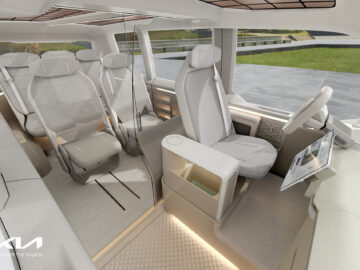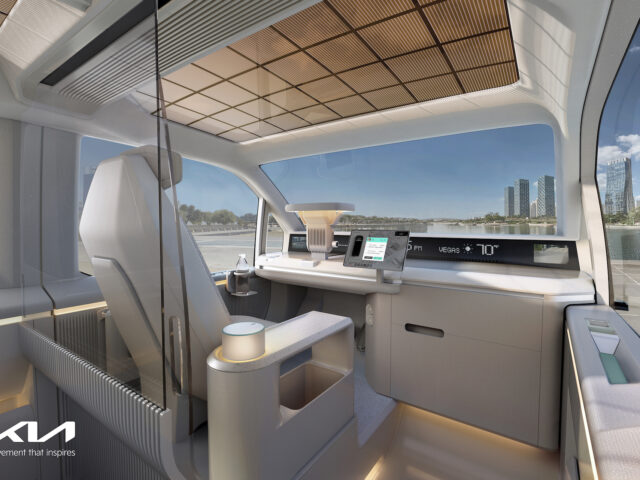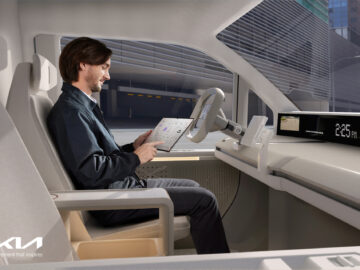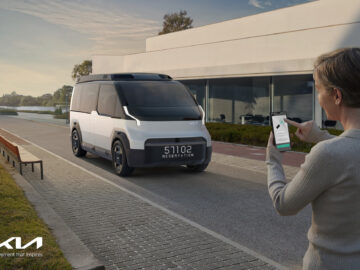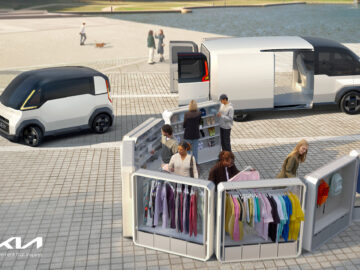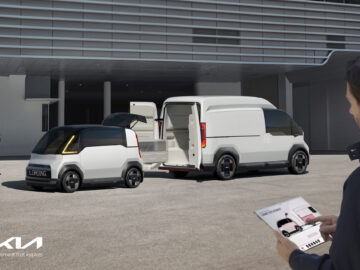Kia steps into electric commercial vehicles: Kia PV5 kicks off in 2025
Customized Kia commercial vehicles
Kia’s future PBVs are comprehensive mobility solutions combining customized electric vehicles with advanced software based on Hyundai Motor Group’s software-to-everything (SDx) strategy. As a Platform Beyond Vehicle, Kia’s PBVs are going to offer unprecedented flexibility and ultimate freedom to both companies and individuals with their customized bodies and interiors.
“With our new PBV strategy, we aim to respond to the needs of customers and communities, focusing on specific market preferences,” said Ho Sung Song, President and CEO of Kia. “Kia’s PBVs are going to help entrepreneurs innovate their business thanks to our customer-centric management system, EV expertise and Hyundai Motor Group’s rapidly evolving SDx strategy. We are excited to show here at CES that we are fully prepared to become the pioneer in the global PBV market,” he added.
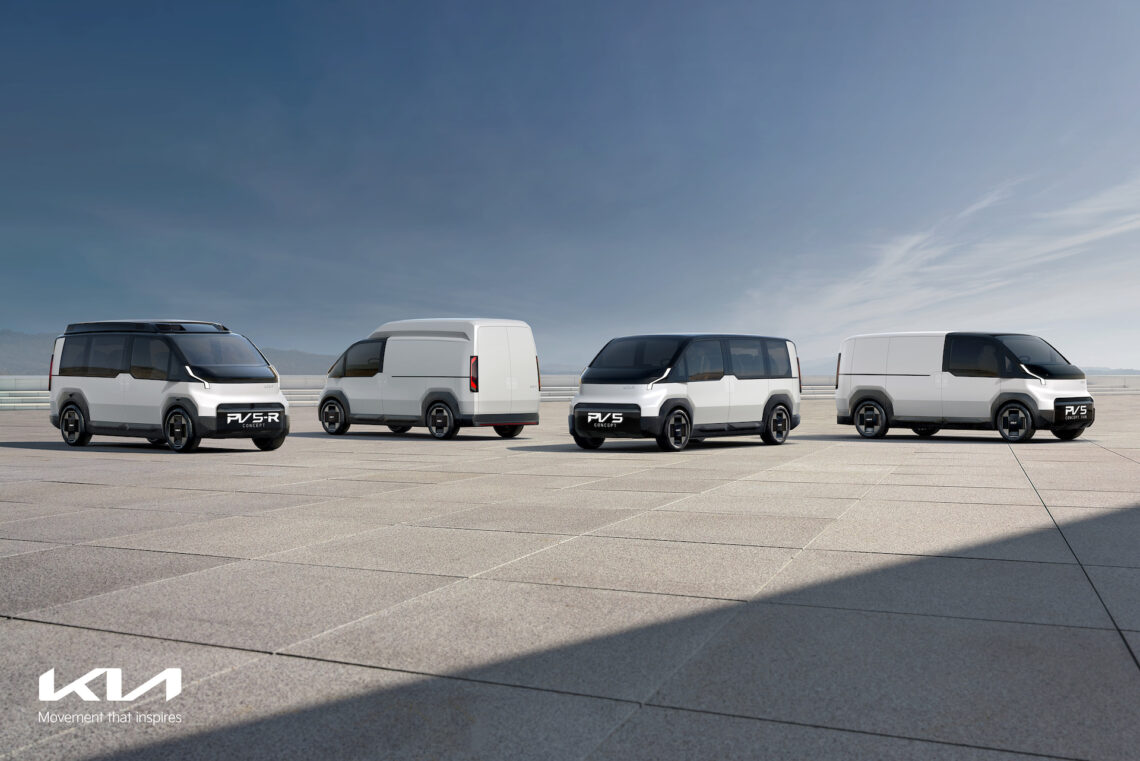
A vision of future mobility
The PBV roadmap consists of three distinct phases. The first phase centers on the introduction of the Kia PV5. This EV is optimized for package delivery companies and utility companies, among others, and offers different conversion options for different customer needs. Data connectivity between the vehicles and external systems enable a software-driven fleet where, for example, route or delivery information can be optimally generated. Custom PBV solutions reduce downtime and increase effectiveness.
In the second phase, Kia will significantly expand the lineup of PBV models and launch AI-based mobility platforms that use data to interact with users and ensure that vehicles are always up-to-date. An integrated PBV solution provides a seamless experience across all devices and software.
In the third phase, Kia’s PBVs will evolve into highly customizable mobility solutions fully integrated with future mobility ecosystems. In this phase, PBVs are evolving into live platforms that bring any idea to reality, and connected, self-driving vehicles are part of smart city control systems. With the emergence of a hyper-connected world where people, PBVs and the social infrastructure are seamlessly connected, Kia can open the door to entirely new lifestyles and forms of enterprise. The advanced PBV ecosystem will be based on Hyundai Motor Group’s future technologies in autonomous driving, advanced air mobility, robotics and the energy grid.
Easy Swap
With Kia’s flexible “Easy Swap” technology, a single vehicle chassis can be used to meet multiple mobility needs. Behind a fixed cab, or “driver zone,” the use of a hybrid electromagnetic and mechanical clutch technology several interchangeable body variants, either ‘life modules’ are attached. Thus, a PBV can be used as a cab during the day, as a van at night and as a recreational vehicle for personal use on weekends.
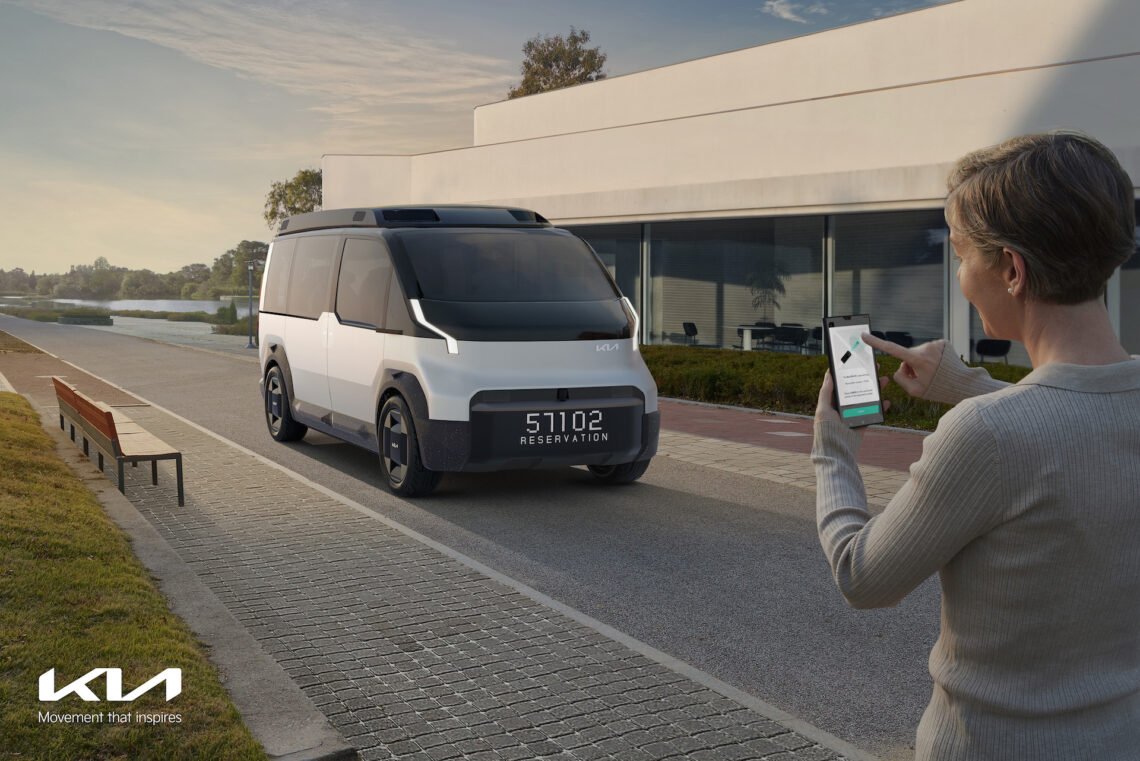
Dynamic Hybrid
The far-reaching modularization is made possible in part by the “Dynamic Hybrid” weldless body construction, which allows the length of the movable parts to be flexibly adapted to the vehicle’s intended use. The specific components are made of high-grade tubular steel and specially developed polymers and are reduced by 55 percent without loss of stiffness. The Dynamic Hybrid technology will be available in a standardized, convenient kit form and allows for a quick and easy transformation of a Kia PV5.
Easy to use
Kia’s main mission is to ensure that the brand’s PBVs are easy and intuitive to operate, no matter where, when or how they are used. Whether the vehicle is intended to transport people, move goods or meet logistical or personal mobility needs, each PBV has a consistent design that reflects its solid and robust nature and exudes a reliable and highly capable attitude. The design contains no unnecessary lines or surfaces and is all about useful features that make life easier for drivers and any passengers. The concepts unveiled at CES give a glimpse of the possibilities.
Nice and spacious
Thanks to the mix of a simple but robust surface design with expressive graphics, the different PV5 models clearly belong together, despite their divergent characters. Each version includes large doors that offer an exceptionally large opening with no visible uprights, allowing effortless entry and exit (or loading). Inside, the extended wheelbase and electric platform create wide, flat open spaces that offer virtually endless storage and use options. The driver has access to an ergonomically designed cabin that can also serve as an office, where the folding steering wheel can be used as a desk lamp.
Sustainability
Kia also puts sustainability at the heart of PBV design. Accordingly, the brand is going to make extensive use of materials such as bioplastics, residuals, bio paint, recycled PET material, felt and bio-PU foam for the production of PBVs.
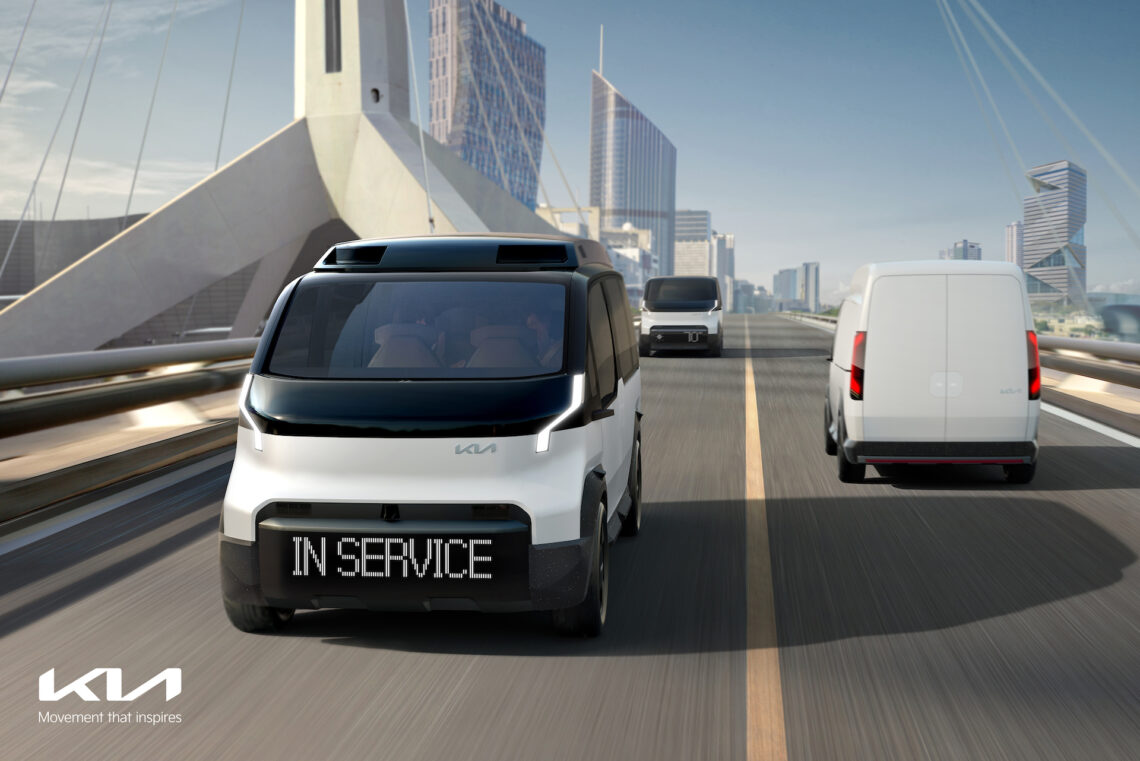
Lineup Kia PV5
Kia will offer the PV5 in several variants in Phase 1, including Basic, Van, High Roof and Chassis Cab versions. Also planned in the future is a Robot Taxi version being developed in cooperation with Motional (a joint venture between HMG and Aptiv).
The second phase expands the PBV ecosystem to include the PV7 and PV1, using cabinet and frame systems to take full advantage of the modular concept.
1) PV7 – The largest vehicle in the lineup, with even more interior space, extended driving range and additional features.
2) PV1 – The smallest model in the series, PV1 is optimized for agile short-distance logistics transport, using new drive modules to minimize the turning radius, even in tight spaces.
3) PBV modularity – An integrated rail system in the roof, floor and sides of the vehicles allows effortless adaptation to individual customer needs. This system also guarantees seamless transfer of goods and items between vehicles, using standardized cabinets and frames. The “rails” within this ecosystem simplify the movement of items between vehicles, while the modular design of functional accessories such as speakers and shelves offer limitless flexibility for a wide range of scenarios.
Modularization
“Kia’s PBVs usher in a new era of seamless everyday business and lifestyle solutions. With unprecedented modularization and flexibility, we can make our customers’ lives easier and better, whether they are stationary or on the road,” said Karim Habib, Executive Vice President and Head of Kia Global Design.
Ready to answer any question
To take full advantage of the opportunities offered by PBVs, Kia is going to launch a dedicated business system that covers every aspect of the process, from the product range to the integration of software solutions and global partnerships.
EVO factory in Autoland Hwaseong
With the construction of a PBV-specific EVO plant in Autoland Hwaseong, Korea, Kia is taking an important step to meet the diverse demands of customers. A hybrid manufacturing approach is being implemented in this plant. Through collaboration with global conversion partners, Kia can offer a wide range of conversions based on the PBV models. The plant will be operational by mid-2025 and will eventually have an annual capacity of 150,000 units.
Kia’s solutions in the areas of In-Vehicle Infotainment (IVI), Fleet Management Systems (FMS) and charging will use vehicle software-based data and AI technologies. This enables customer-focused solutions, predictive maintenance to minimize downtime and customized loading programs.
The IVI solution aims to improve everyday life by recognizing user preferences in real time and providing relevant contextual data. Among other things, it provides access to the Kia PBV App Market and third-party apps so customers can have the latest information and entertainment on the go. By connecting to enterprise-specific apps previously limited to mobile devices, service ease and reliability of information improves, providing a holistic user experience.
PBV fleet management solution (FMS).
The PBV fleet management solution (FMS) allows customers to efficiently monitor multiple vehicles. It provides insight into sales, inventory and deliveries, which benefits mobility and logistics companies. Features include inventory monitoring, temperature control and intelligent route planning. The solution streamlines fleet management with real-time data and AI integration to predict maintenance and achieve optimal operational efficiency.
Vehicle-to-Everything
Kia’s future EV charging solution is also focused on maximum efficiency. For example, the technology takes into account battery charge levels, routes, schedules and breaks. Kia aims to provide a total energy solution by using an innovative charging infrastructure that allows high-density batteries to power mobile devices and emergency equipment. This is made possible by the brand’s advanced Vehicle-to-Everything (V2X) technology.
Partners
The integration of IVI, FMS and EV charging solutions is offered by Kia with unified software, enabling package solutions that can be adapted to different business environments. To this end, Kia has formed partnerships with companies such as Uber, Coupang, CJ Logistics, Kakao Mobility and Dubai Taxi Corporation.
“Kia’s PBV business is the culmination of our customer-centric business approach. Strong partnerships are driving our transformation into a provider of sustainable mobility solutions,” said Pierre-Martin Bos, Vice President and BDM Director Kia PBV Business Division.
Integration of robotics, AAM and autonomous driving
Future activities and partnering are important to strengthen the integration of robotics, AAM and autonomous driving to provide the best PBV mobility solution within smart city environments.
1) Robotics – Kia is using robotics, including Boston Dynamics’ Stretch and Spot robots, to improve logistics automation and 24-hour quality control in its smart factories.
2) AAM – Kia is working with Supernal, a subsidiary of Hyundai Motor Group, to accelerate the development of smart cities by introducing multimodal services and mobility hubs based on advanced air mobility.
3) Autonomous driving – Kia is working with Motional to roll out autonomous driving technology. A concrete example is the plan to develop a software-based PV5 Robot Taxi. The partnership aims to combine Kia’s competitiveness with Motional’s advanced Level 4 autonomous driving technology to maximize global business opportunities.
Hyundai Motor Group’s software capabilities extend beyond vehicle applications to various areas of mobility, such as robotics, aircraft and autonomous driving. The goal: enable operation, control and management to foster an era of hyperconnectivity between people and devices.
‘Beyond mobillity’ in sustainable way
Kia has been rolling out the Plan S strategy at full speed since 2021 to adapt to the rapidly changing market. Following the launch of multiple award-winning models, including the EV6 and EV9, Kia aims to solidify its position as a leading provider of sustainable mobility solutions by 2030 by launching a host of other models, including the EV3 and EV4. Striving to realize its vision and meet the diverse needs of customers, the relaunch of the Kia brand has further led to the development of a sustainable, customer-centric management system.
During the transformation, Kia has already achieved a number of key sustainability goals including the implementation of ten indispensable sustainability items to be applied to all new Kia models to achieve sustainability on a large scale.


